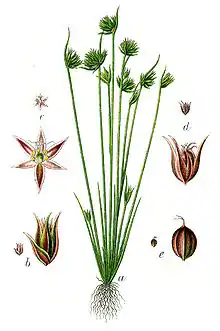Juncus capitatus
Juncus capitatus is a species of rush known by the common names dwarf rush[2] and leafybract dwarf rush.[3] It is native to Europe, Asia and North Africa. It is also an introduced species in parts of North America such as California and the Gulf Coast. It grows in moist areas, such as wet sand, vernal pools, and ditches.
| Juncus capitatus | |
|---|---|
 | |
| 1796 illustration[1] | |
| Scientific classification | |
| Kingdom: | Plantae |
| Clade: | Tracheophytes |
| Clade: | Angiosperms |
| Clade: | Monocots |
| Clade: | Commelinids |
| Order: | Poales |
| Family: | Juncaceae |
| Genus: | Juncus |
| Species: | J. capitatus |
| Binomial name | |
| Juncus capitatus | |
Description
The dwarf rush is a small annual herb not exceeding ten centimeters in height. The stems are erect and thready, flat or somewhat corrugated. The leaves are basal and up to 3 or 4 centimeters long. The plant is green to red or brownish in color. Each stem bears an inflorescence of up to six clustered flowers. The pointed bracts at the base of the inflorescence are often over a centimeter long, longer the flower cluster itself, and are somewhat leaflike, giving the species its common name. Each flower has pointed outer tepals and thinner, shorter, oval-shaped inner tepals. There are three stamens. The fruit is a tiny oval-shaped capsule one to two millimeters long.[4]
Distribution and habitat
The dwarf rush is native to Europe, West Asia and North and East Africa.[5] In the British Isles it is only known from Anglesey, Cornwall and the Channel Islands, and is rare in all these locations.[4] It germinates in autumn and grows in places where water stands in winter and which dry up completely in summer, meaning the plant faces little competition. These locations include rock ledges on sea cliffs, around outcrops of serpentine rock and in dune slacks. In some locations it has sometimes been thought to be locally extinct, but then reappeared later.[6]
References
- from Deutschlands Flora in Abbildungen. Author: Johann Georg Sturm. Painter: Jacob Sturm.
- BSBI List 2007 (xls). Botanical Society of Britain and Ireland. Archived from the original (xls) on 26 June 2015. Retrieved 17 October 2014.
- USDA, NRCS (n.d.). "Juncus capitatus". The PLANTS Database (plants.usda.gov). Greensboro, North Carolina: National Plant Data Team. Retrieved 22 January 2016.
- McClintock, David; Fitter, R.S.R. (1961). The Pocket Guide to Wild Flowers. London: Collins. p. 211.
- "J. capitatus Weigel" (PDF). Flora Iberica. Retrieved 18 March 2022.
- "Juncus capitatus". Online Atlas of the British and Irish Flora. Archived from the original on 27 August 2021. Retrieved 16 April 2020.